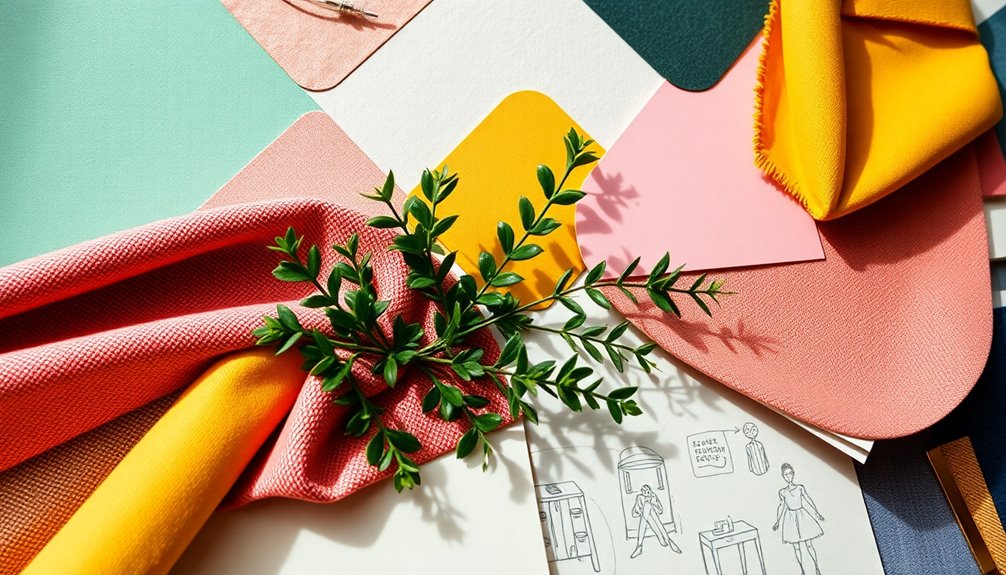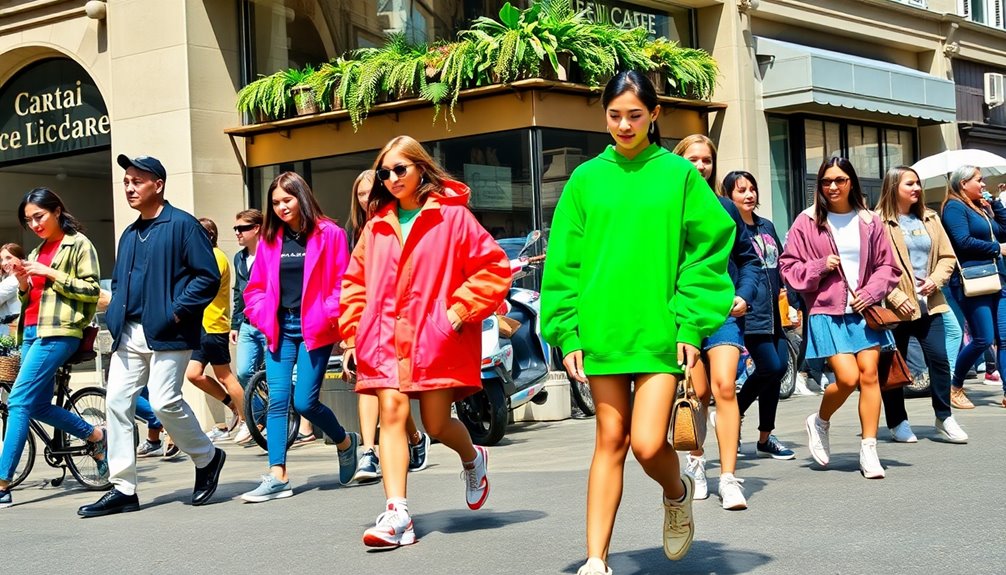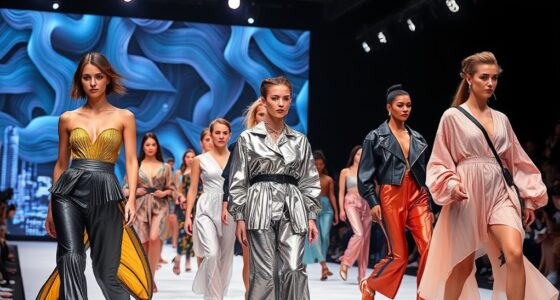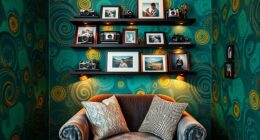In 2025, you'll find design trends leaning towards bold and maximalist aesthetics, featuring vibrant colors and expressive typography. Think dynamic layouts that create energy and movement, while nostalgic elements evoke cherished memories. Sustainable practices are also important, focusing on eco-friendly materials and earthy palettes. You can expect innovative uses of 3D elements and engaging dynamic illustrations that simplify complex ideas. As AI evolves, it enhances creativity, allowing for unique designs that feel both authentic and modern. Explore these concepts further to uncover the full potential for your next project.
Key Takeaways
- Embrace bold and maximalist aesthetics with vibrant colors, oversized typography, and dynamic layouts to create engaging visual experiences.
- Incorporate nostalgic and retro elements, blending familiar shapes and vintage typography to evoke emotional connections with audiences.
- Utilize dynamic illustrations and motion graphics to simplify complex ideas and enhance engagement across various platforms.
- Adopt sustainable design practices by using eco-friendly materials and earthy color palettes to promote ecological awareness in your projects.
- Explore 3D elements and AI tools to add depth and enhance creativity, while ensuring a focus on authenticity and innovative design solutions.
Bold and Maximalist Aesthetics
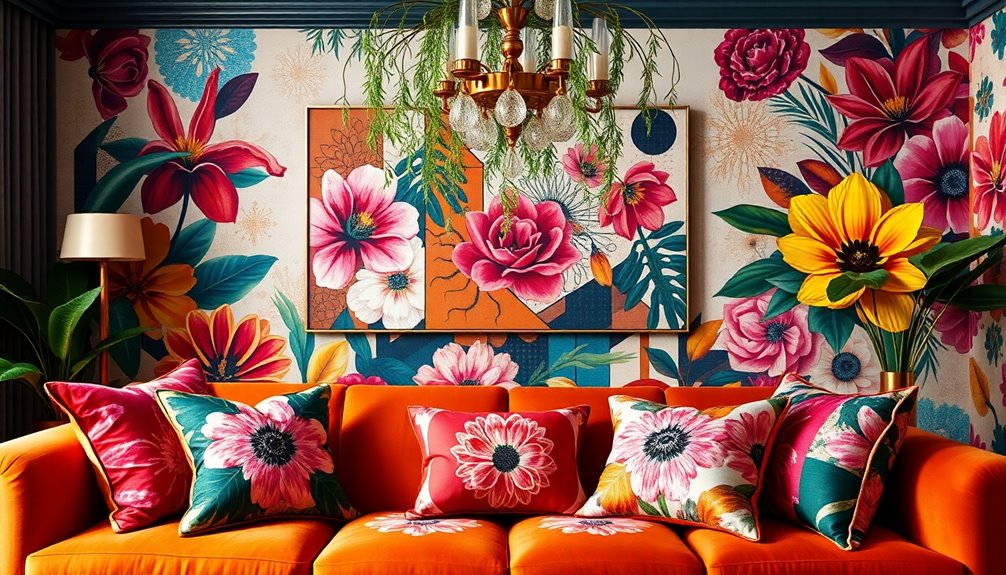
Bold and maximalist aesthetics are taking center stage in design for 2025. You'll notice a shift toward vibrant colors and intricate patterns that create visually striking designs. These elements capture attention and convey strong brand messages, making your projects pop.
Expressive typography plays an essential role, featuring oversized fonts and unique combinations that challenge traditional design norms.
Dynamic layouts with asymmetry and irregular spacing foster a sense of movement and energy, engaging viewers in unexpected ways. You'll find that this style often incorporates childlike textures and organic lines, celebrating imperfection and raw creativity over precise, AI-generated designs.
This approach encourages you to embrace the playful and exuberant aspects of visual communication. Maximalism stands in stark contrast to minimalism, focusing on bold, clashing colors and layered elements.
By embracing these bold and maximalist aesthetics, you can craft designs that evoke emotion and tell a story. Interestingly, the rise of eco-friendly options in various industries, including beauty and grooming, reflects a broader trend towards sustainability that can also influence design choices. So, don't shy away from experimenting with color, texture, and form—2025 is all about releasing your creativity and making a statement.
Embrace the chaos and let your designs reflect the vibrant world around you!
Sustainable Design Practices
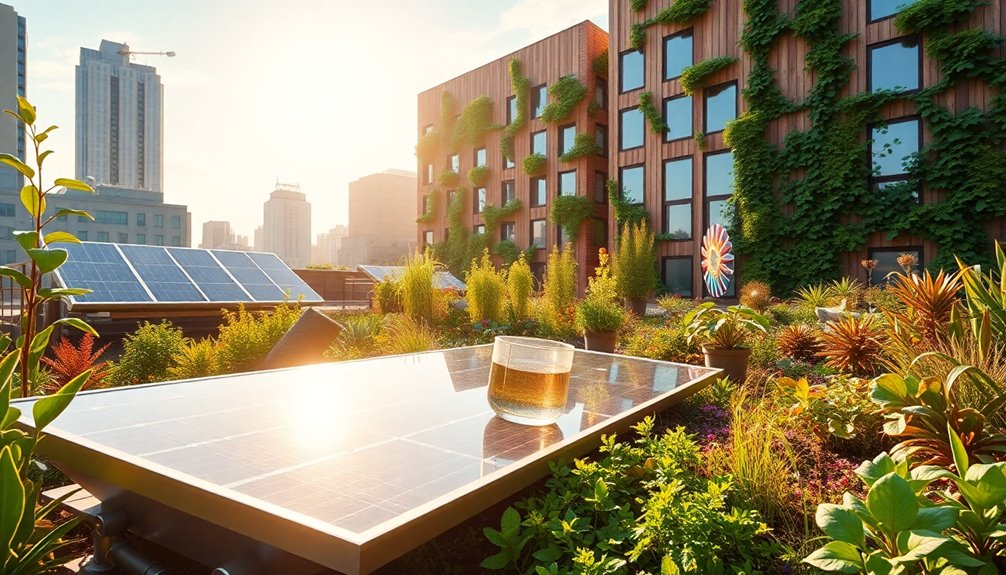
In light of growing environmental concerns, sustainable design practices are becoming essential for brands looking to resonate with eco-conscious consumers.
By prioritizing sustainable design, you can enhance your brand's visual appeal and demonstrate a commitment to the planet.
Here are some effective strategies to evaluate:
- Use eco-friendly materials to minimize your environmental footprint.
- Incorporate earthy color palettes that reflect nature and promote ecological awareness.
- Implement strategies to reduce waste and encourage recycling in your processes.
- Explore biodegradable packaging options that align with sustainable values.
- Draw inspiration from nature's patterns and textures to create compelling designs.
- Consider integrating eco-friendly practices such as utilizing locally sourced materials to further support sustainability in your designs.
3D Elements and Depth
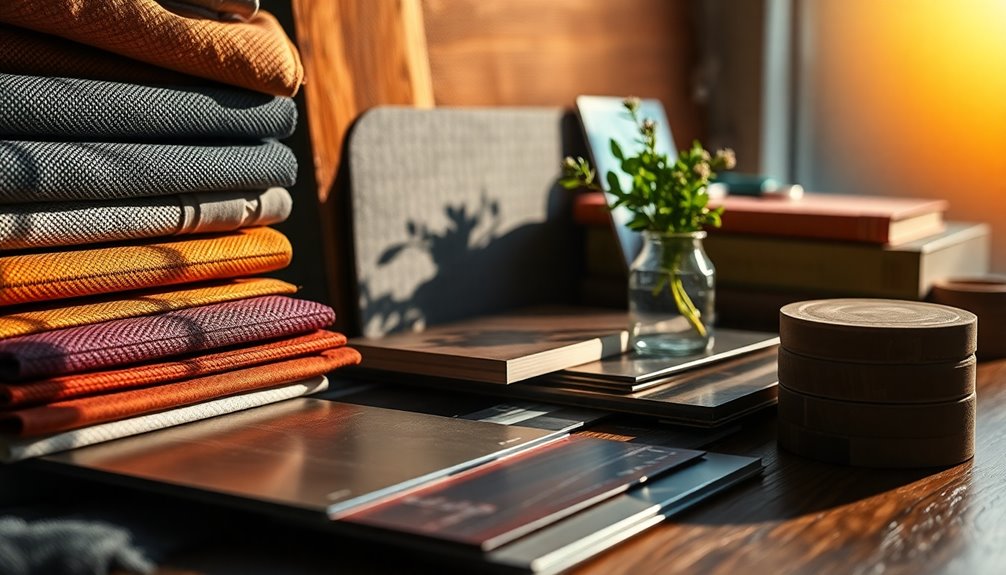
As brands embrace sustainable design practices, they're also exploring new dimensions in creativity. One of the standout trends is the use of Three-Dimensional Effects, which adds depth and intrigue to your projects. By incorporating shadows and layers, you enhance visual interest, drawing viewers into your narrative.
Interactive Elements play an important role in digital design, allowing users to engage directly with 3D components. This not only appeals to tech-savvy audiences but also elevates the overall user experience, making your designs memorable.
Visual storytelling becomes more impactful with 3D graphics, as they create immersive environments that resonate with viewers on a deeper level. Moreover, the Tactile Quality of depth in design stimulates the senses, making it particularly appealing for industries like tech, gaming, and innovative products.
You can enjoy the benefits of efficient iteration with modern 3D design tools, enabling you to adapt quickly while maintaining a competitive edge. Incorporating depth into your work is essential for staying relevant in today's creative industries. Additionally, integrating elements of music therapy can further enhance emotional well-being and creativity in your design process.
Embrace these design trends to inspire your projects and captivate your audience like never before.
Dynamic Illustrations and Motion
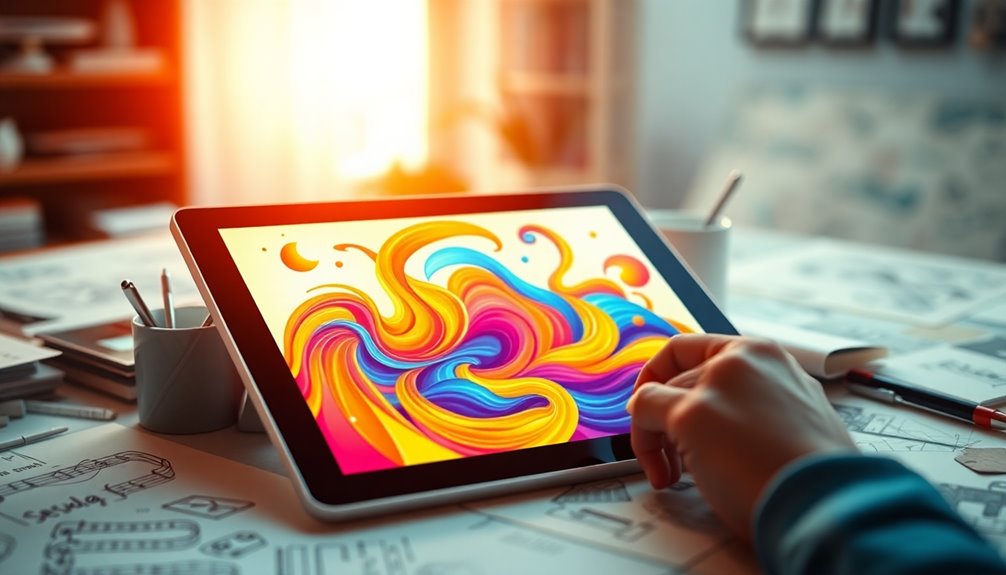
Dynamic illustrations and motion graphics can transform your visual storytelling into a mesmerizing experience.
By integrating custom artwork that aligns with your brand identity, you make your message more relatable and memorable.
Plus, adding animated elements not only simplifies complex ideas but also keeps your audience engaged longer.
Engaging Visual Storytelling
Engaging audiences through visual storytelling is becoming increasingly essential, and dynamic illustrations paired with motion graphics are leading the charge. These elements not only elevate your branding but also enhance user engagement, making your narratives more immersive.
Consider these key benefits:
- Simplifying complex concepts: Dynamic illustrations can articulate intricate ideas creatively, making them accessible to everyone.
- Boosting information retention: Research shows that designs featuring motion graphics can improve retention by up to 65%.
- Enhancing visual identity: Custom artwork with bold colors and playful elements captures attention and conveys your brand message effectively.
- Increasing interactivity: Incorporating animated elements, like GIFs and videos, resonates with tech-savvy audiences and encourages deeper engagement.
- Versatile applications: Use these techniques across web, print, and social media platforms to reach a broader audience.
Moreover, the rise of generative AI in media is transforming how visual content is created, allowing for even more innovative storytelling techniques.
Custom Artwork Integration
Integrating custom artwork into your branding strategy can greatly elevate your visual storytelling. By embracing custom artwork integration, you enhance your brand identity through unique illustrations that resonate with your target audience.
Dynamic illustrations, featuring vibrant colors and playful elements, effectively convey complex narratives, making your brand memorable in both digital and print formats.
Incorporating motion graphics adds another layer to your strategy. These animated elements can boost user engagement by up to 80%, capturing attention on social media and websites. When you utilize GIFs and animations, you create a lively, interactive experience that can increase audience retention by 50%. This engagement keeps users coming back for more.
The versatility of custom illustrations allows for seamless application across various mediums, ensuring a cohesive brand message throughout all platforms. Whether it's on your website, print materials, or social media, consistent use of custom artwork strengthens your brand identity and storytelling. Additionally, leveraging AI-driven solutions can optimize the creation process, allowing for tailored content that resonates even more with your audience.
Nostalgic and Retro Inspirations

When you incorporate vintage design elements, you tap into a cultural nostalgia that resonates deeply with audiences.
By using familiar shapes, muted colors, and retro typography, you can evoke cherished memories while appealing to modern tastes. This connection not only adds emotional depth to your work but also influences consumer behavior in powerful ways. Additionally, the incorporation of natural elements in vintage designs can enhance the overall ambiance and promote a sense of tranquility.
Vintage Design Elements
Vintage design elements are making a strong comeback, blending nostalgia with modern aesthetics in a mesmerizing way. These elements evoke a sense of familiarity while enhancing emotional connections, making them ideal for brand storytelling. By utilizing vintage aesthetics, you can tap into shared cultural memories that resonate deeply with your audience.
Consider these key features when incorporating vintage design elements:
- Geometric shapes that reflect the simplicity of past styles.
- Muted color palettes reminiscent of early digital design, adding sophistication.
- Bold patterns that draw inspiration from historical aesthetics, creating visual interest.
- Authenticity that generates trust and familiarity with your brand.
- Nostalgic yet modern elements that appeal to diverse audiences.
This intentional structure balances design elements, ensuring your work remains visually engaging while invoking a sense of nostalgia.
As you explore these vintage elements, remember that they can effectively connect with consumers who appreciate the beauty of the past. Embrace this trend to elevate your projects and resonate with those who cherish the warmth of nostalgia while enjoying contemporary design.
Cultural Nostalgia Connection
Many designers have found that tapping into cultural nostalgia not only enriches their work but also creates a powerful emotional connection with audiences. Nostalgic design often incorporates elements from past decades, like vintage-inspired typography and cultural symbols, to evoke familiarity and warmth.
Here's a snapshot of key elements that define this trend:
| Element | Description |
|---|---|
| Bright Colors | Bold hues from the 80s and 90s that attract attention. |
| Vintage-Inspired Typography | Serif fonts and playful scripts that enhance nostalgia. |
| Cultural Symbols | Familiar motifs like cassette tapes that create shared experiences. |
| Retro Aesthetics | Geometric shapes and patterns that resonate with comfort. |
Typography as a Central Element
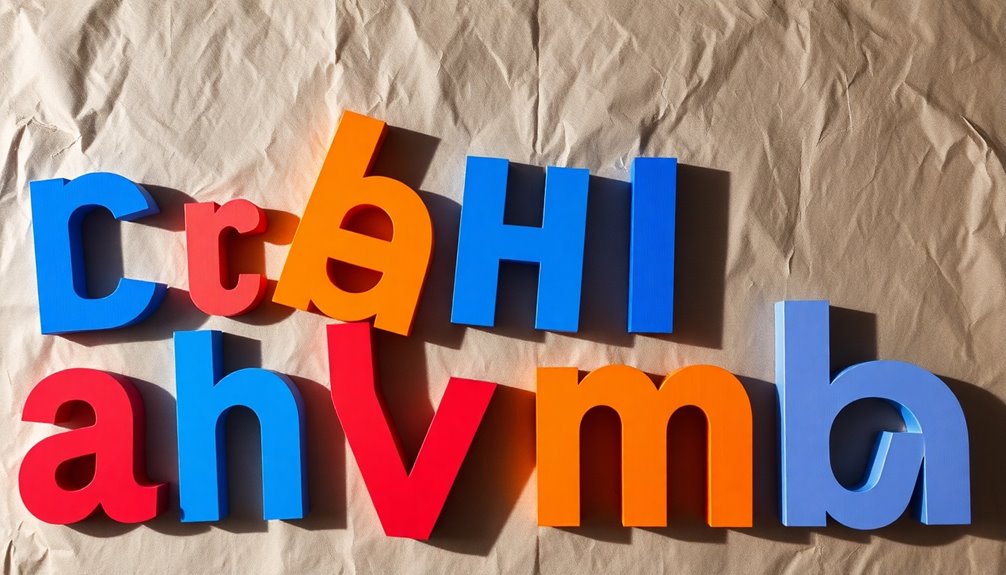
Typography has become a cornerstone of modern design, capturing attention and communicating brand identity with striking clarity.
Today, you can leverage typography as a powerful design element to enhance your projects. Here are some key trends to reflect upon:
- Bold fonts: These oversized typefaces draw the eye and convey a strong message.
- Custom fonts: Tailoring your typography can create a unique brand identity that resonates emotionally with your audience.
- Visual storytelling: Typography can narrate your brand's story, making connections that go beyond mere text.
- Experimental typography: Embrace creativity by using 3D effects or playful arrangements to challenge traditional norms.
- Readability: Combining different font styles and weights improves user engagement, ensuring your message is communicated effectively.
- Incorporating AI-driven analysis in your typography choices can further enhance the effectiveness of your design by ensuring it resonates well with your target audience.
Structured Scrapbook Aesthetics

As modern design continues to evolve, structured scrapbook aesthetics emerge as a vibrant and engaging way to tell stories visually. This style prioritizes layered designs, combining overlapping images, cutouts, and stickers to create a visually rich narrative that resonates with personal stories.
You'll find that the playful nature of structured scrapbooking encourages creative ideas, making it perfect for capturing memories in a unique way.
Incorporating nostalgic textures like polaroids, tape, and torn edges evokes familiarity and warmth, bridging the gap between past and present.
Hand-drawn doodles and other visual elements celebrate imperfections, enhancing the tactile quality of your projects. This authenticity allows your work to connect with audiences seeking individuality and relatability in design. Additionally, blending modern elements with antiques in country decor can infuse your scrapbook projects with character and charm, enhancing their visual narrative.
Minimalist and Serene Designs

In a world overflowing with visual noise, minimalist and serene designs offer a rejuvenating escape by embracing simplicity and elegance.
You can create a calming environment that resonates with your audience by focusing on essential elements and eliminating distractions. This approach enhances clarity and user experiences, making your designs feel more sophisticated.
Consider these key aspects when implementing minimalist designs:
- Serene color palettes: Use muted tones and ample white space to evoke tranquility.
- Clean lines: Simplify shapes and structures to improve navigation and interaction.
- Essential elements: Prioritize what's necessary, eliminating the superfluous to enhance functionality.
- Modern UX design: Incorporate minimalist aesthetics to streamline user journeys.
- Sophistication: Communicate messages clearly and concisely, appealing to luxury, tech, and wellness brands. Additionally, consider incorporating eco-friendly paints to promote a healthier, more sustainable environment in your design projects.
Evolution of AI in Design
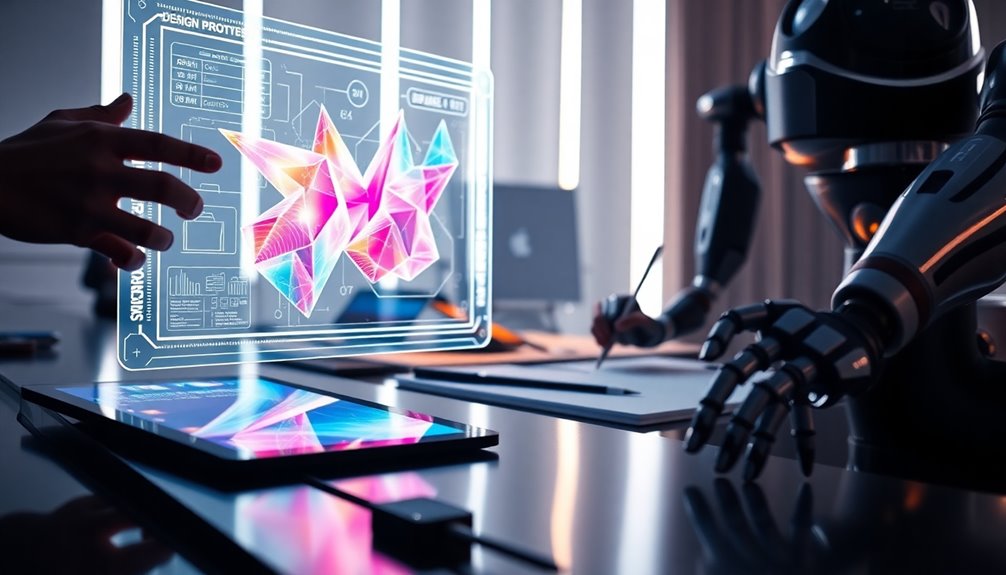
AI is increasingly transforming the design landscape, shifting from flashy visuals to more subtle enhancements that support designers' creativity. Over the years, graphic design trends have evolved, and now, AI technologies play an essential role in the design process.
Designers seeking innovative design solutions can leverage these tools for rapid prototyping and iteration, markedly saving time and costs.
Today, the focus is on creating natural aesthetics in AI-generated designs. This move away from hyperrealism emphasizes authenticity and organic qualities, aligning with contemporary cultural shifts.
AI tools assist with tasks like color selection and layout optimization, enhancing your overall creative experience and efficiency.
As you collaborate with AI, you're not just using a tool; you're fostering a partnership that can lead to new aesthetic trends. This synergy enables you to explore creative avenues that reflect shifts in consumer preferences, ensuring your designs resonate with today's audience.
The evolution of AI in design isn't about replacing human creativity; it's about amplifying it, providing you with the support needed to push boundaries and create compelling, authentic visuals that stand out. Furthermore, understanding the AI bifurcation is essential for designers to navigate the complexities of modern creativity and technology.
Frequently Asked Questions
What Are Things That Inspire the Design?
You can find inspiration for design in various places. Nature's organic shapes and colors can spark creativity, while art galleries expose you to different movements that influence your style.
Exploring typography through custom fonts adds uniqueness to your work. Embracing technology, like augmented reality and AI, opens up new possibilities.
Finally, drawing from personal experiences and emotions can help you create designs that resonate deeply with your audience, making your work more impactful.
What Are Some Innovative Trends You Are Noticing in Digital Design?
"Variety is the spice of life," and that's exactly what you're seeing in digital design today.
Bold typography captures attention like never before, while motion graphics enhance engagement and storytelling.
You're also witnessing a shift towards inclusive design, catering to diverse user needs, and the rise of 3D elements that add depth.
Custom illustrations are taking center stage, allowing brands to create unique identities that resonate emotionally with their audience.
Embrace these trends!
What Is the Next Big Design Trend in 2024?
In 2024, you'll notice bold typography taking center stage, with oversized fonts making a statement and enhancing brand messages.
Sustainable design practices will also rise, using eco-friendly materials that resonate with conscious consumers.
Motion graphics will captivate your audience, transforming static visuals into engaging stories.
Maximalism will challenge minimalism, introducing vibrant colors and playful layouts.
Plus, the incorporation of 3D elements will bring depth, creating immersive experiences that draw viewers in.
What Do You Think the Next Big Design Trend Will Be?
I think the next big design trend will focus on sustainable practices and vibrant maximalism.
You'll likely see brands embracing eco-friendly materials while using bold colors and expressive typography to capture attention.
Motion graphics will enhance storytelling, making your designs more dynamic and engaging.
Additionally, incorporating 3D elements could create immersive experiences.
Expect a nostalgic twist too, as retro aesthetics resonate with consumers looking for familiarity in a fast-paced digital world.
Conclusion
As you immerse yourself in 2025's design trends, remember that embracing bold aesthetics and sustainable practices can truly transform your projects. Did you know that 70% of consumers are more likely to engage with brands that prioritize eco-friendly designs? This statistic highlights the emotional connection people have with sustainability. So, let your creativity flourish while making choices that resonate with your audience. The future of design is vibrant, thoughtful, and filled with endless possibilities—are you ready to take the leap?
